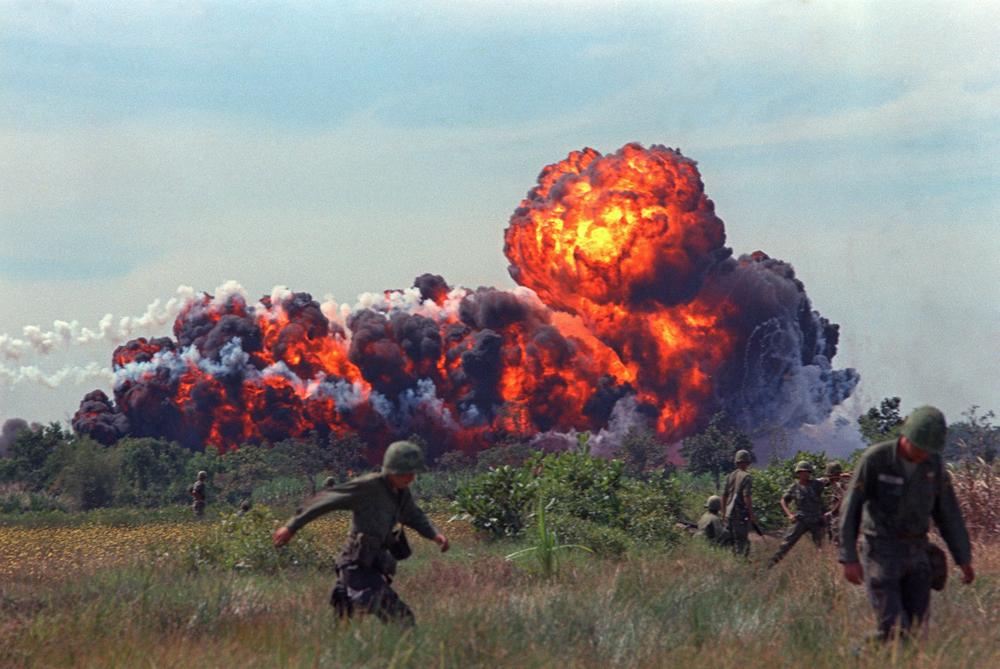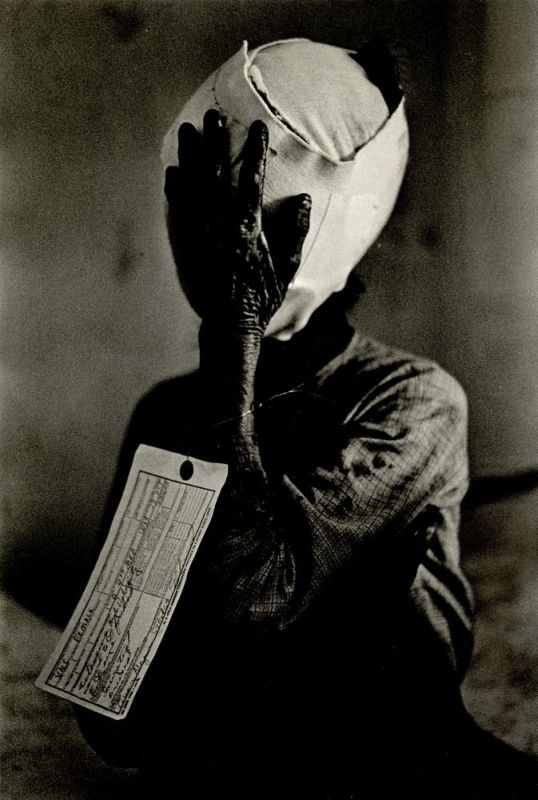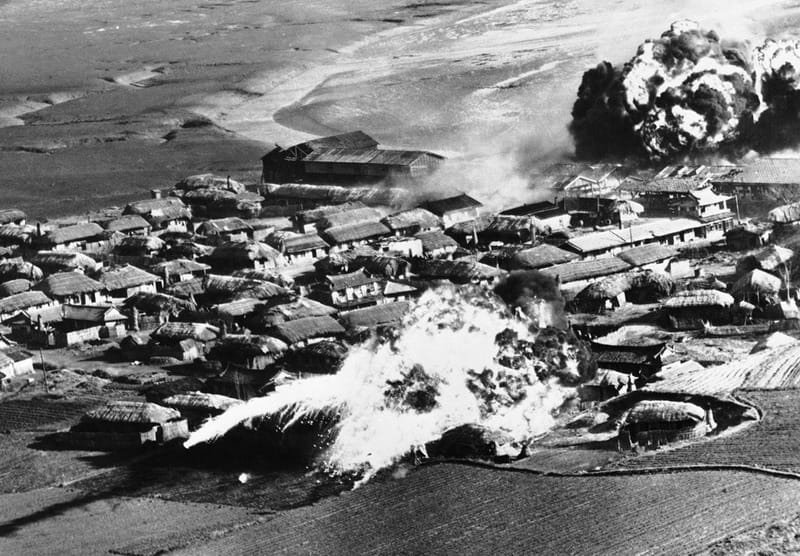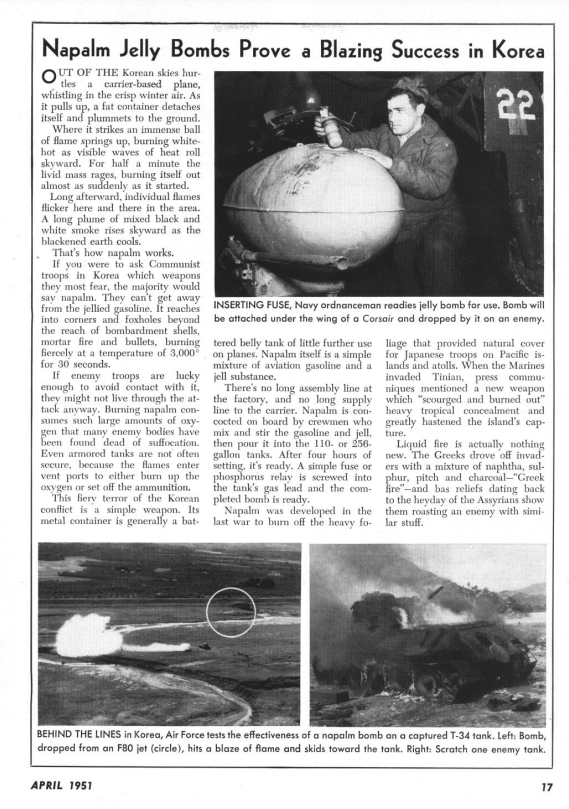More languages
More actions
Verda.Majo (talk | contribs) m (added link and adjusted wording) Tag: Visual edit |
Verda.Majo (talk | contribs) (added some photos (napalm explosion, napalm victim) and some more information about the napalm use in Iraq) Tag: Visual edit |
||
| Line 1: | Line 1: | ||
'''Napalm''' is often used as the generic name of several flammable liquids used as a weapon, primarily referring to any petrochemical such as gasoline, kerosene, or benzene that has had chemicals added to it to thicken it to form a sticky, combustible gel substance. The word "napalm" is derived from a portmanteau of two common ingredients used for this gelling purpose, naphthenic acid and palmitic acid. Napalm can be used in flamethrowers as well as in the form of bombs. It clings to whatever it touches and is hard to remove, creating a large, hotly burning area around the target. It is relatively cheap, easy to transport, and simple to prepare. In addition to its devastating physical effects, it is also employed for its psychological effects.<ref name=":0">Silverman, Jacob. [https://science.howstuffworks.com/napalm.htm “How Napalm Works.”] December 15, 2008. [https://web.archive.org/web/2/https://science.howstuffworks.com/napalm.htm Archived] 2022-09-22.</ref> | [[File:A napalm strike erupts in a fireball near U.S. troops on patrol in South Vietnam.jpg|thumb|A napalm explosion during the Vietnam War.]] | ||
'''Napalm''' is often used as the generic name of several flammable liquids used as a weapon, primarily referring to any petrochemical such as gasoline, kerosene, or benzene that has had chemicals added to it to thicken it to form a sticky, combustible gel substance. The word "napalm" is derived from a portmanteau of two common ingredients used for this gelling purpose, naphthenic acid and palmitic acid. Napalm can be used in flamethrowers as well as in the form of bombs. It clings to whatever it touches and is hard to remove, creating a large, hotly burning area around the target. It is relatively cheap, easy to transport, and simple to prepare. In addition to its devastating physical effects, it is also employed for its psychological effects.<ref name=":0">Silverman, Jacob. [https://science.howstuffworks.com/napalm.htm “How Napalm Works.”] December 15, 2008. [https://web.archive.org/web/2/https://science.howstuffworks.com/napalm.htm Archived] 2022-09-22.</ref><ref name=":4">Lindsay Murdoch. [https://www.smh.com.au/opinion/us-tried-to-napalm-truth-in-justifying-the-iraq-war-20130318-2gb0v.html “US Tried to Napalm Truth in Justifying the Iraq War.”] The Sydney Morning Herald. March 18, 2013. [https://web.archive.org/web/20220923143705/https://www.smh.com.au/opinion/us-tried-to-napalm-truth-in-justifying-the-iraq-war-20130318-2gb0v.html Archived] 2022-09-23.</ref> | |||
When contacting human skin, napalm clings to the skin and melts off the flesh. Napalm can cause severe burns to the skin and body, asphyxiation, unconsciousness, and death. Napalm bombs generate carbon monoxide while simultaneously removing oxygen from the air. The air in the bombing area can be 20 percent or more carbon monoxide. Once ignited, napalm can burn at more than 5,000 degrees Fahrenheit (2,760 degrees Celsius). In some cases, people have been boiled to death in rivers made hot by the heat of napalm bombs.<ref name=":0" /> One firebomb released from a plane can cause damage over an area of 2,500 square yards (2,090 square meters).<ref>[https://www.earth.com/earthpedia-articles/napalm/ “What Is Napalm?”] Earth.com. March 16, 2019. [https://web.archive.org/web/2/https://www.earth.com/earthpedia-articles/napalm/ Archived] 2022-09-22.</ref> | When contacting human skin, napalm clings to the skin and melts off the flesh. Napalm can cause severe burns to the skin and body, asphyxiation, unconsciousness, and death. Napalm bombs generate carbon monoxide while simultaneously removing oxygen from the air. The air in the bombing area can be 20 percent or more carbon monoxide. Once ignited, napalm can burn at more than 5,000 degrees Fahrenheit (2,760 degrees Celsius). In some cases, people have been boiled to death in rivers made hot by the heat of napalm bombs.<ref name=":0" /> One firebomb released from a plane can cause damage over an area of 2,500 square yards (2,090 square meters).<ref>[https://www.earth.com/earthpedia-articles/napalm/ “What Is Napalm?”] Earth.com. March 16, 2019. [https://web.archive.org/web/2/https://www.earth.com/earthpedia-articles/napalm/ Archived] 2022-09-22.</ref> | ||
[[File:Heavily bandaged woman burned by napalm, Vietnam.jpg|thumb|Heavily bandaged woman burned by napalm, with a tag attached to her arm which reads "VNC Female" meaning Vietnamese civilian.]] | |||
A description of napalm's effects on human flesh is given in ''The Korean War: A History'' by Bruce Cumings:<blockquote>One day Pfc. Jeames Ransome, Jr.'s unit suffered a "friendly" hit of this wonder weapon: his men rolled in the snow in agony and begged him to shoot them, as their skin burned to a crisp and peeled back "like fried potato chips." Reporters saw case after case of civilians drenched in napalm--the whole body "covered with a hard, black crust sprinkled with yellow pus."<ref name=":1">Cumings, Bruce. [https://archive.org/details/koreanwarhistory0000cumi/page/n7/mode/2up The Korean War: A History.] 2010. Modern Library, New York. ISBN: 978-0-679-64357-9. p. 152-153.</ref></blockquote>One of the more recent uses of napalm was by U.S. forces during the [[Iraq War|2003 invasion of Iraq]].<ref name=":2">[http://www.napalmbiography.com/ “Napalm, an American Biography.”] 2013. [https://web.archive.org/web/20220610111227/http://www.napalmbiography.com/ Archived] 2022-06-10. </ref><ref name=":0" /> | A description of napalm's effects on human flesh is given in ''The Korean War: A History'' by Bruce Cumings:<blockquote>One day Pfc. Jeames Ransome, Jr.'s unit suffered a "friendly" hit of this wonder weapon: his men rolled in the snow in agony and begged him to shoot them, as their skin burned to a crisp and peeled back "like fried potato chips." Reporters saw case after case of civilians drenched in napalm--the whole body "covered with a hard, black crust sprinkled with yellow pus."<ref name=":1">Cumings, Bruce. [https://archive.org/details/koreanwarhistory0000cumi/page/n7/mode/2up The Korean War: A History.] 2010. Modern Library, New York. ISBN: 978-0-679-64357-9. p. 152-153.</ref></blockquote>One of the more recent uses of napalm was by U.S. forces during the [[Iraq War|2003 invasion of Iraq]].<ref name=":2">[http://www.napalmbiography.com/ “Napalm, an American Biography.”] 2013. [https://web.archive.org/web/20220610111227/http://www.napalmbiography.com/ Archived] 2022-06-10. </ref><ref name=":0" /> Colonel Randolph Alles, who commanded Marine Air Group 11 during the war, was quoted as saying that napalm had a <nowiki>''big psychological effect'' on an enemy and that ''</nowiki>The generals love napalm".<ref name=":4" /> | ||
== History == | == History == | ||
| Line 11: | Line 14: | ||
=== Use in Second World War === | === Use in Second World War === | ||
During the Second World War, U.S. forces used a 6 percent mixture of napalm in flamethrowers. Napalm bombs became a prominent part of aerial campaigns later in the war. In 1944, Allied forces dropped the first napalm bombs on Tinian Island in 1944, which is part of the [[Commonwealth of the Northern Mariana Islands|Northern Mariana Islands]] in the northern Pacific Ocean. Napalm devastated Japanese cities, especially since many houses were made of wood. A napalm bombing campaign against Tokyo on March 9, 1945, killed an estimated 100,000 people and burned 15 square miles (39 square kilometers) of the city. Allied forces also used napalm in European fighting, with around 3.4 kilotons of napalm bombs--up to 50 percent of bombs dropped--falling on Dresden in February 1945.<ref name=":0" /> | During the Second World War, U.S. forces used a 6 percent mixture of napalm in flamethrowers. Napalm bombs became a prominent part of aerial campaigns later in the war. In 1944, Allied forces dropped the first napalm bombs on Tinian Island in 1944, which is part of the [[Commonwealth of the Northern Mariana Islands|Northern Mariana Islands]] in the northern Pacific Ocean. Napalm devastated Japanese cities, especially since many houses were made of wood. A napalm bombing campaign against Tokyo on March 9, 1945, killed an estimated 100,000 people and burned 15 square miles (39 square kilometers) of the city. Allied forces also used napalm in European fighting, with around 3.4 kilotons of napalm bombs--up to 50 percent of bombs dropped--falling on Dresden in February 1945.<ref name=":0" /> | ||
[[File: | [[File:Thatched huts go up in flames after B-26 bombers unload napalm bombs on a village near Hanchon, North Korea, on May 10, 1951 (AP photo).png|thumb|Thatched huts go up in flames after B-26 bombers unload napalm bombs on a village near Hanchon, North Korea, on May 10, 1951.]] | ||
=== Use in Korean War === | === Use in Korean War === | ||
| Line 19: | Line 22: | ||
During the conflict, U.S. forces dropped a quarter of a million pounds (113,398 kilograms) of napalm bombs every day, mostly in the form of the M-47 napalm bomb and the M-74 incendiary bomb.<ref name=":0" /> | During the conflict, U.S. forces dropped a quarter of a million pounds (113,398 kilograms) of napalm bombs every day, mostly in the form of the M-47 napalm bomb and the M-74 incendiary bomb.<ref name=":0" /> | ||
According to U.S. Naval Captain Walter Karig, in his book ''Battle Report: The War in Korea'':<blockquote>[W]e killed civilians, friendly civilians, and bombed their homes; fired whole villages with the occupants--women and children and ten times as many hidden Communist soldiers--under showers of napalm, and the pilots came back to their ships stinking of vomit twisted from their vitals by the shock of what they had to do.<ref>Walter Karig; Malcolm W Cagle; Frank A Manson; et al (1952). ''Battle Report: The War in Korea'' (pp. 111-112). New York: Rinehart.</ref></blockquote> | According to U.S. Naval Captain Walter Karig, in his book ''Battle Report: The War in Korea'':[[File:Napalm jelly bombs prove a blazing success in korea - All Hands April 1951 - Copy.png|thumb|The April 1951 edition of U.S. Navy "All Hands" magazine praising napalm as a "blazing success" in Korea. |362x362px]]<blockquote>[W]e killed civilians, friendly civilians, and bombed their homes; fired whole villages with the occupants--women and children and ten times as many hidden Communist soldiers--under showers of napalm, and the pilots came back to their ships stinking of vomit twisted from their vitals by the shock of what they had to do.<ref>Walter Karig; Malcolm W Cagle; Frank A Manson; et al (1952). ''Battle Report: The War in Korea'' (pp. 111-112). New York: Rinehart.</ref></blockquote> | ||
=== Use in Vietnam War === | === Use in Vietnam War === | ||
| Line 30: | Line 33: | ||
=== Use in Iraq === | === Use in Iraq === | ||
In 2003, U.S. pilots admitted to using napalm on Iraqi soldiers. The form of napalm used at this time was MK-77. | In 2003, U.S. pilots admitted to using napalm on Iraqi soldiers. The form of napalm used at this time was MK-77. The pilots described how they had dropped massive fireballs of napalm on Iraqi forces as marines battled towards Baghdad. Incendiary bombs were also dropped in April 2003 near bridges over the Saddam Canal and Tigris River. On August 4, 2003, a Pentagon spokesman admitted that <nowiki>''</nowiki>Mark 77<nowiki>''</nowiki> incendiary devices were used by the US forces, which he acknowledged were <nowiki>''</nowiki>remarkably similar<nowiki>''</nowiki> to napalm weapons. John Pike, defence analyst with GlobalSecurity.org, a US research group, said: <nowiki>''</nowiki>You can call it something other than napalm, but it's napalm.<nowiki>''</nowiki> Colonel Randolph Alles, who commanded Marine Air Group 11 during the war, was quoted as saying that napalm had a <nowiki>''</nowiki>big psychological effect<nowiki>''</nowiki> on an enemy and that <nowiki>''</nowiki>The generals love napalm".<ref name=":4" /> | ||
== References == | == References == | ||
<references /> | <references /> | ||
Revision as of 15:19, 23 September 2022

Napalm is often used as the generic name of several flammable liquids used as a weapon, primarily referring to any petrochemical such as gasoline, kerosene, or benzene that has had chemicals added to it to thicken it to form a sticky, combustible gel substance. The word "napalm" is derived from a portmanteau of two common ingredients used for this gelling purpose, naphthenic acid and palmitic acid. Napalm can be used in flamethrowers as well as in the form of bombs. It clings to whatever it touches and is hard to remove, creating a large, hotly burning area around the target. It is relatively cheap, easy to transport, and simple to prepare. In addition to its devastating physical effects, it is also employed for its psychological effects.[1][2]
When contacting human skin, napalm clings to the skin and melts off the flesh. Napalm can cause severe burns to the skin and body, asphyxiation, unconsciousness, and death. Napalm bombs generate carbon monoxide while simultaneously removing oxygen from the air. The air in the bombing area can be 20 percent or more carbon monoxide. Once ignited, napalm can burn at more than 5,000 degrees Fahrenheit (2,760 degrees Celsius). In some cases, people have been boiled to death in rivers made hot by the heat of napalm bombs.[1] One firebomb released from a plane can cause damage over an area of 2,500 square yards (2,090 square meters).[3]

A description of napalm's effects on human flesh is given in The Korean War: A History by Bruce Cumings:
One day Pfc. Jeames Ransome, Jr.'s unit suffered a "friendly" hit of this wonder weapon: his men rolled in the snow in agony and begged him to shoot them, as their skin burned to a crisp and peeled back "like fried potato chips." Reporters saw case after case of civilians drenched in napalm--the whole body "covered with a hard, black crust sprinkled with yellow pus."[4]
One of the more recent uses of napalm was by U.S. forces during the 2003 invasion of Iraq.[5][1] Colonel Randolph Alles, who commanded Marine Air Group 11 during the war, was quoted as saying that napalm had a ''big psychological effect'' on an enemy and that ''The generals love napalm".[2]
History
During the First World War, gasoline was used in combat flamethrowers. However, the essential problem with gasoline as a weapon was that it burned out too quickly to be effective, and would drip off of targets. To increase its effectiveness, the U.S. Chemical Warfare used latex from rubber trees to gel gasoline. With natural rubber, the mixed gasoline now could be shot further, stuck to the target better, and burned longer.
When the U.S. entered the Pacific in the Second World War, the U.S. access to natural rubber supply was short, and therefore they sought an alternative for creating gelled incendiary weapons. From 1942 to 1943, a team of chemists led by Louis F. Fieser at Harvard University eventually formulated napalm by mixing naphthenic and palmitic acids with gasoline.[6]
Use in Second World War
During the Second World War, U.S. forces used a 6 percent mixture of napalm in flamethrowers. Napalm bombs became a prominent part of aerial campaigns later in the war. In 1944, Allied forces dropped the first napalm bombs on Tinian Island in 1944, which is part of the Northern Mariana Islands in the northern Pacific Ocean. Napalm devastated Japanese cities, especially since many houses were made of wood. A napalm bombing campaign against Tokyo on March 9, 1945, killed an estimated 100,000 people and burned 15 square miles (39 square kilometers) of the city. Allied forces also used napalm in European fighting, with around 3.4 kilotons of napalm bombs--up to 50 percent of bombs dropped--falling on Dresden in February 1945.[1]

Use in Korean War
Regarding napalm use in the Korean War, Author Bruce Cumings writes that "oceans of [napalm] were dropped on Korea silently or without notice in America" and that it had a devastating effect on the DPRK's cities and industrial installations.[4] On the website "Napalm, an American Biography" it is stated that during the Korean war, "The New York Times and other newspapers printed hundreds of articles that mentioned napalm. Criticism, if it occurred at all, was fleeting."[5] In general, the effects of napalm on human bodies was not widely publicized at this time, while its effectiveness as a weapon was highly praised.
During the conflict, U.S. forces dropped a quarter of a million pounds (113,398 kilograms) of napalm bombs every day, mostly in the form of the M-47 napalm bomb and the M-74 incendiary bomb.[1]
According to U.S. Naval Captain Walter Karig, in his book Battle Report: The War in Korea:

[W]e killed civilians, friendly civilians, and bombed their homes; fired whole villages with the occupants--women and children and ten times as many hidden Communist soldiers--under showers of napalm, and the pilots came back to their ships stinking of vomit twisted from their vitals by the shock of what they had to do.[7]
Use in Vietnam War
As in previous wars, napalm was used extensively in the Vietnam War. In particular, the formulation Napalm-B was used extensively during the war, up to 400,000 tons (362,874 metric tons).[1]
In Vietnam, the U.S. military used napalm to destroy forests that North Vietnamese soldiers relied on for cover. The extensive use of napalm in Vietnam, along with Agent Orange, herbicides and a variety of unexploded landmines and munitions, have contributed to Vietnam's ongoing environmental and public health problems.
Opposition to napalm among U.S. citizens
A grass-roots protest movement against the incendiary and its manufacturer Dow Chemical Corporation began in northern California in 1965. It spread across the country in the late 1960s. The use of napalm grew to be considered emblematic of the imperialist aggression in Vietnam and was highly criticized by the antiwar movement.[6]
Use in Iraq
In 2003, U.S. pilots admitted to using napalm on Iraqi soldiers. The form of napalm used at this time was MK-77. The pilots described how they had dropped massive fireballs of napalm on Iraqi forces as marines battled towards Baghdad. Incendiary bombs were also dropped in April 2003 near bridges over the Saddam Canal and Tigris River. On August 4, 2003, a Pentagon spokesman admitted that ''Mark 77'' incendiary devices were used by the US forces, which he acknowledged were ''remarkably similar'' to napalm weapons. John Pike, defence analyst with GlobalSecurity.org, a US research group, said: ''You can call it something other than napalm, but it's napalm.'' Colonel Randolph Alles, who commanded Marine Air Group 11 during the war, was quoted as saying that napalm had a ''big psychological effect'' on an enemy and that ''The generals love napalm".[2]
References
- ↑ 1.0 1.1 1.2 1.3 1.4 1.5 Silverman, Jacob. “How Napalm Works.” December 15, 2008. Archived 2022-09-22.
- ↑ 2.0 2.1 2.2 Lindsay Murdoch. “US Tried to Napalm Truth in Justifying the Iraq War.” The Sydney Morning Herald. March 18, 2013. Archived 2022-09-23.
- ↑ “What Is Napalm?” Earth.com. March 16, 2019. Archived 2022-09-22.
- ↑ 4.0 4.1 Cumings, Bruce. The Korean War: A History. 2010. Modern Library, New York. ISBN: 978-0-679-64357-9. p. 152-153.
- ↑ 5.0 5.1 “Napalm, an American Biography.” 2013. Archived 2022-06-10.
- ↑ 6.0 6.1 Alan Rohn. "Napalm in Vietnam War." January 18, 2014. TheVietnamWar.info. Archived 2022-09-22.
- ↑ Walter Karig; Malcolm W Cagle; Frank A Manson; et al (1952). Battle Report: The War in Korea (pp. 111-112). New York: Rinehart.
